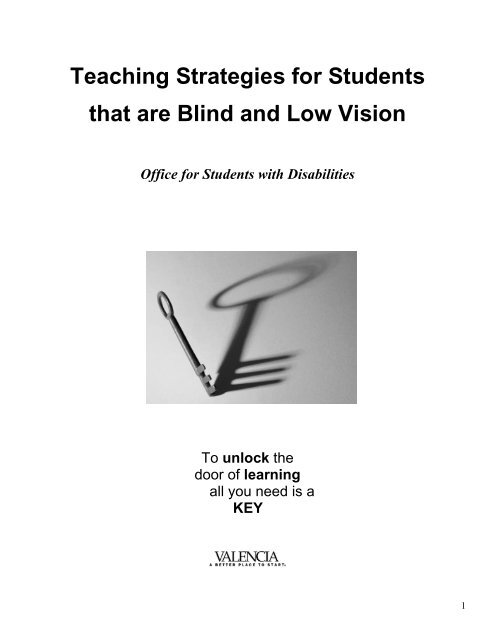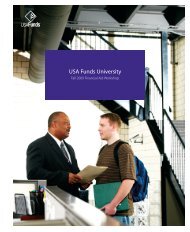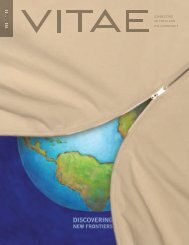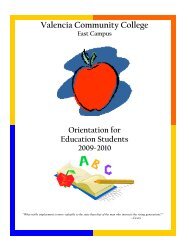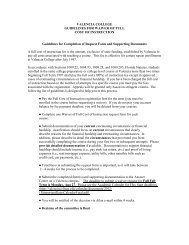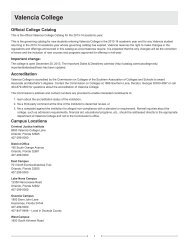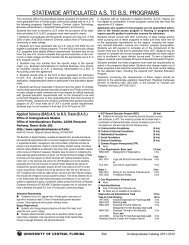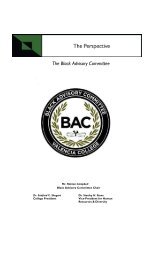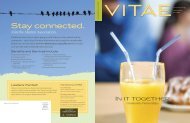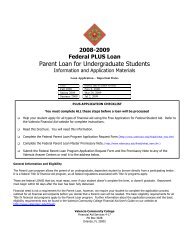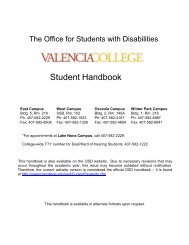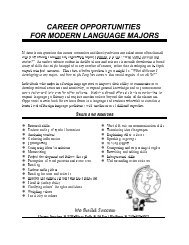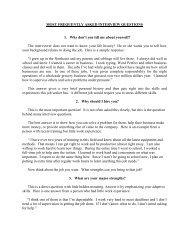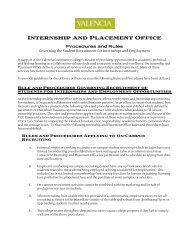Teaching Strategies for Students that are Blind ... - Valencia College
Teaching Strategies for Students that are Blind ... - Valencia College
Teaching Strategies for Students that are Blind ... - Valencia College
Create successful ePaper yourself
Turn your PDF publications into a flip-book with our unique Google optimized e-Paper software.
<strong>Teaching</strong> <strong>Strategies</strong> <strong>for</strong> <strong>Students</strong><br />
<strong>that</strong> <strong>are</strong> <strong>Blind</strong> and Low Vision<br />
Office <strong>for</strong> <strong>Students</strong> with Disabilities<br />
To unlock the<br />
door of learning<br />
all you need is a<br />
KEY<br />
1
<strong>Teaching</strong> <strong>Students</strong> <strong>that</strong> <strong>are</strong> <strong>Blind</strong> or Low Vision<br />
TABLE OF CONTENTS<br />
INTRODUCTION ………………………………………………………………. page 3<br />
Vision Facts …………………………………………………………………………………… page 3<br />
<strong>Blind</strong>ness Basics …………………………………………………………………………… page 3<br />
Functional Limitations ………………………………………………………………… page 3<br />
Useful In<strong>for</strong>mation ……………………………………………………………………… page 4<br />
GENERAL POINTS …………………………………………………………… page 5<br />
GUIDING A BLIND PERSON ………………………………………………… page 6<br />
GOOD PRACTICE GUIDELINES ……………………………………………. page 8<br />
Lecture …………………………………………………………………………………………… page 8<br />
Group Work/Discussions……………………………………………………………… page 9<br />
Printed Material …………………………………………………………………………… page 10<br />
Writing Assignments …………………………………………………………………… page 11<br />
Lab Instruction …………………………………………………………………………… page 12<br />
Exam Arrangements …………………………………………………………………… page 12<br />
Assistive Technology …………………………………………………………………… page 13<br />
Universal Design <strong>for</strong> Learning (UDL) ……………………………………… page 15<br />
DISTANCE EDUCATION …………………………………………………….. page 17<br />
Website Accessibility Introduction ………………………………………… page 17<br />
Designing an Accessible WebCT Course ………………………………… page 17<br />
Validating Your Work ………………………………………………………………… page 18<br />
MULTIMEDIA GUIDELINES …………………………………………………. page 19<br />
Audio Description In<strong>for</strong>mation ………………………………………………… page 19<br />
PDF Documents ……………………………………………………………………………… page 20<br />
SPECIFIC SUBJECT INSTRUCTION ……………………………………….. page 21<br />
Science Lab Specifics ………………………………………………………………… page 21<br />
Mathematics Instruction …………………………………………………………… page 23<br />
Technical, Scientific and Mathematical Tables in Braille …… page 24<br />
Foreign Language Instruction …………………………………………………… page 25<br />
Music Instruction ………………………………………………………………………… page 29<br />
RESOURCES …………………………………………………………………... page 33<br />
REFERENCES …………………………………………………………………. page 36<br />
2
<strong>Teaching</strong> <strong>Students</strong> <strong>that</strong> <strong>are</strong> <strong>Blind</strong> or Low Vision<br />
INTRODUCTION<br />
Vision Facts<br />
• <strong>Blind</strong>ness refers to the disability of students <strong>that</strong> cannot read printed text, even when<br />
enlarged.<br />
• Low vision refers to the disability of students who have some usable vision, but cannot read<br />
standard-size text, have field deficits (<strong>for</strong> example, cannot see peripherally or centrally but<br />
can see well in other ranges), or other visual impairments.<br />
• For sighted people, vision serves as the primary source <strong>for</strong> in<strong>for</strong>mation. Estimates of how<br />
much sighted people learn visually range from 75% to 85%.<br />
• A person who is visually impaired has difficulty seeing even with his or her glasses on.<br />
• Visual acuity is measured and reported as numbers. 20/20 is normal vision. Larger<br />
denominators indicate less acute vision. Legal blindness is a visual of 20/200 or worse, with<br />
best correction, in the better eye.<br />
• Legal blindness can also result from a field restriction of 20 degrees or less in both eyes.<br />
• Over 75% of the people in the U.S who <strong>are</strong> legally blind have some residual vision. 11.5<br />
million people have some degree of visual impairment.<br />
<strong>Blind</strong>ness Basics<br />
• Acuity: The ability to see sharply and clearly; when acuity is reduced the ability to read is<br />
impaired.<br />
• Field of View: The <strong>are</strong>a within the environment <strong>that</strong> can be seen; if peripheral, or side,<br />
vision is lost, the result is a “tunnel vision” effect <strong>that</strong> primary impacts mobility; if central<br />
vision is lost the result is an inability to see detail, and the ability to read is affected.<br />
• Contrast: The ability to discern objects in the <strong>for</strong>eground from background; without the<br />
ability to discriminate objects, tool manipulation, picture identification, and writing may be<br />
affected.<br />
Functional Limitations<br />
• Difficulty finding objects<br />
• Difficulty identifying objects<br />
• Difficulty seeing objects edges, and discriminating <strong>for</strong>eground/background differences<br />
• Missing objects when reaching <strong>for</strong> them<br />
• Disappearing objects in visual field (the <strong>are</strong>a of vision)<br />
• Tripping, falling, or bumping into objects when walking or moving about room<br />
• Difficulty reading print<br />
• Reduced reading rate<br />
• Reduced reading endurance<br />
• Difficulty seeing handwriting<br />
• Difficulty seeing writing on board, or projector<br />
• Difficulty seeing characters or numbers in books/media<br />
• Inconsistency in seeing objects over time (fluctuating vision)<br />
3
Useful In<strong>for</strong>mation<br />
<strong>Students</strong> with visual impairments <strong>are</strong> constantly challenged by classroom instructional strategies.<br />
Although they can easily hear lectures and discussions, it can be difficult <strong>for</strong> them to access class<br />
syllabi, textbooks, overhead projector transp<strong>are</strong>ncies, power point presentations, maps, written<br />
exams, demonstrations, DVDs, videos and films. A large part of traditional learning is visual;<br />
<strong>for</strong>tunately, many students with visual disabilities have developed strategies to learn.<br />
<strong>Students</strong> <strong>that</strong> <strong>are</strong> <strong>Blind</strong> or Low Vision vary considerably. For example, some have no vision; others<br />
<strong>are</strong> able to see large <strong>for</strong>ms; and still others can see print if magnified. They use a variety of<br />
accommodations, equipment, and compensatory strategies based upon their widely varying needs.<br />
Many make use of taped textbooks, e-text, and computer screen reading softw<strong>are</strong> such as JAWS,<br />
extended time <strong>for</strong> exams or projects, a reader/scribe during exams, large print books, and Brailled<br />
materials.<br />
For many students, advancements in modern technology have made learning much more accessible.<br />
<strong>Students</strong> <strong>that</strong> <strong>are</strong> <strong>Blind</strong> or Low Vision can utilize enlarged print or screen reading softw<strong>are</strong> on the<br />
computer. Machines <strong>are</strong> available to enlarge the print of any printed material, to convert printed<br />
material to Braille, or convert printed material into a synthesized voice. <strong>Students</strong> may also use talking<br />
calculators or a tape recorder.<br />
You should not modify academic standards <strong>for</strong> visually impaired students. All students must meet the<br />
required level of understanding and per<strong>for</strong>mance competencies <strong>for</strong> the course, although there may<br />
need to be modifications in the evaluation or testing method.<br />
If you have problems when teaching a student who is blind or low vision, first decide if the problem is<br />
related to the disability or if it is a problem <strong>that</strong> any student could have. Consult with the student if you<br />
have concerns about accommodations or his/her learning. Other resources to assist you in working<br />
with students with vision loss include: the Office <strong>for</strong> <strong>Students</strong> with Disabilities, faculty who have<br />
worked with other visually impaired students, and web resources such as:<br />
• The Faculty Room http://www.washington.edu/doit/Faculty -OR-<br />
• EASI http://www.rit.edu/~easi/<br />
4
GENERAL POINTS<br />
• Speak to the class upon entering and leaving the classroom.<br />
• Identify yourself by name, don't assume <strong>that</strong> the student who is blind or low vision will<br />
recognize you by your voice even though you have met be<strong>for</strong>e.<br />
• Speak directly to a student who is blind, NOT through a companion or third party.<br />
• Orally, let the student know if you need to move or need to end a conversation.<br />
• Call the student by name if you want his/her attention.<br />
• Verbally acknowledge the questions of a student who is blind, they cannot see a head shake<br />
or gesture.<br />
• Don’t allow the hand of a student who is blind to dangle in the air. If it is obviously their<br />
intention to shake hands, grasp their hand and greet them.<br />
• Use descriptive words such as straight, <strong>for</strong>ward, left, etc. in relation to the student's body<br />
orientation. Be specific in directions and avoid the use of vague terms with unusable<br />
in<strong>for</strong>mation, such as "over there," "here," "this," etc.<br />
• If a person who is blind is approaching and may bump into you, simply say “hello” so they will<br />
be aw<strong>are</strong> someone is in their path.<br />
• Don't worry about using phrases <strong>that</strong> refer to sight, e.g. “see you later,” these <strong>are</strong> commonly<br />
used expressions. <strong>Students</strong> with vision loss can still "see" what is meant by such expressions.<br />
• Describe and familiarize the student to the classroom, laboratory, equipment, supplies,<br />
materials, etc. Once a student is orientated, maintain a consistent classroom environment.<br />
• Give verbal notice of room changes, special meetings, or assignments.<br />
• Tell the student if a room they <strong>are</strong> familiar with has been rearranged.<br />
• Don't leave obstructions where they may be walked into.<br />
• Don’t move the possessions of a person who is blind without letting them know.<br />
• Do not pet or touch guide dogs when they <strong>are</strong> wearing their harness. Guide dogs <strong>are</strong> working<br />
animals ‘on duty.’ It can be hazardous <strong>for</strong> the visually impaired person if the dog is distracted.<br />
• <strong>Students</strong> who have had no vision since birth may also have difficulty understanding verbal<br />
descriptions of visual materials and abstract concepts. Consider the description, "This diagram<br />
of ancestral lineage looks like a tree." If one has never seen a tree, it may not be readily<br />
app<strong>are</strong>nt <strong>that</strong> the structure of note has several lines of ancestry which can be traced back to<br />
one central family. However, students who lost their vision later in life may find it easier to<br />
understand such verbal descriptions. By using enhanced verbal descriptions in your class,<br />
blind students as well as sighted benefit. In making comparisons or analogies, use familiar<br />
objects <strong>that</strong> don't depend on prior visual knowledge. Foods or objects found around the house<br />
<strong>are</strong> useful.<br />
• Demonstrations based on color differences may be more difficult <strong>for</strong> students with blindness to<br />
participate in and understand than demonstrations which emphasize changes in shape,<br />
temperature, or texture.<br />
• Offer to read written in<strong>for</strong>mation <strong>for</strong> a person with a visual impairment, when appropriate.<br />
• When assisting a student <strong>that</strong> is blind in signing their name, place a pen in their hand, and then<br />
guide it to the line. You may use a signature guide or the edge of a piece of heavy paper to<br />
show them the direction of the line. For a student with limited vision, you may use a marker to<br />
draw over the line to make it more visible. Additionally, a student <strong>that</strong> is blind may have a<br />
signature stamp instead of signing with a pen.<br />
• Don’t take advantage of a student who is blind by communicating around them through<br />
gestures and signs to a third person.<br />
• When showing an object to a person <strong>that</strong> is blind, ask the person to place their hand on top of<br />
yours, and then place your hand on the object. This allows the person to have a reference to<br />
the object<br />
5
GUIDING A BLIND PERSON<br />
• Ask if assistance is required but don't assume <strong>that</strong> it is. A person may wish to be guided or just<br />
require some directions.<br />
• Ask how the person would like to be guided - some people will take your arm, others would<br />
prefer you to take their arm.<br />
• Explain changes in ground surface, <strong>for</strong> example moving from carpet onto tiles.<br />
• Explain where you <strong>are</strong> going and what is happening, <strong>for</strong> example when you <strong>are</strong> waiting to<br />
cross the road, approaching obstacles, entering different rooms.<br />
• When approaching stairs, explain whether they go up or down and approximately how many<br />
steps there <strong>are</strong>. Allow the blind person to be between you and the handrail.<br />
• Don't leave people 'stranded.' If you <strong>are</strong> leaving them alone, make sure they have a wall or<br />
chair to hold, and they know where they <strong>are</strong>.<br />
• Take your cue from the blind person — ask if you <strong>are</strong> unsure of anything.<br />
STANCE<br />
GUIDE: Stand with your arm relaxed at your side or bent at the elbow.<br />
FOLLOWER: Your arm should be bent at the elbow, placing you one half step behind the guide.<br />
Keeping the elbow bent <strong>for</strong> long periods of time can be uncom<strong>for</strong>table <strong>for</strong> the guide.<br />
Experienced guides and followers can often travel just as well with the guide's hand<br />
dropped to a vertical position.<br />
NOTE: Walk at a pace <strong>that</strong> is com<strong>for</strong>table <strong>for</strong> both people. The guide should not be "dragging or<br />
towing" the follower and the follower should not be pushing the guide.<br />
NARROW PASSAGE<br />
6
NARROW PASSAGE continued<br />
GUIDE: Continue facing <strong>for</strong>ward, move your arm diagonally across your back.<br />
FOLLOWER: Straighten out your arm and move directly behind the guide thus following effectively in<br />
single file.<br />
TURNING AROUND or ABOUT FACE<br />
(to turn in a small space, or to avoid confusing the follower)<br />
GUIDE: Ask the follower to "about face." Turn in to face the follower. Offer your other arm. Complete<br />
the turn once the follower has grasped your arm.<br />
FOLLOWER: Face the guide. Contact the guide's other arm. Release your original grasp. Assume<br />
the normal grasp on the new arm.<br />
CHANGING SIDES<br />
(be<strong>for</strong>e stairs or to avoid an obstacle)<br />
GUIDE: Ask the follower to change sides. Bring your arm behind you.<br />
FOLLOWER: Grasp the guide's arm with your free hand above your other hand. Release your<br />
original grasp and slide <strong>that</strong> hand across the guide's back to the free arm. Bring your<br />
second hand across to the guide's other arm. Assume the normal grasp position.<br />
7
GOOD PRACTICE GUIDELINES<br />
The good practice guidelines outlined below <strong>are</strong> intended to make course material and methods more<br />
accessible to visually impaired students. Remember <strong>that</strong> improving access <strong>for</strong> students <strong>that</strong> have a<br />
visual impairment will benefit all students in a group, particularly those with learning disabilities.<br />
Lecture<br />
When offering direction or in<strong>for</strong>mation to the learner with vision loss, it is paramount <strong>that</strong> the<br />
in<strong>for</strong>mation be organized or structured logically. In<strong>for</strong>mation given to people with vision loss has to<br />
be processed without the benefit of body language, environmental cues and visual memory.<br />
Consider how you would understand directions given to you verbally from home to work, without<br />
using pictures or images in your thoughts. It is very important <strong>that</strong> educators be able to give<br />
concrete, sequential verbal direction to learners. Tape record your own lecture. Critique it. Ask<br />
yourself, “Could I follow this lecture if I were <strong>Blind</strong> or visually impaired?”<br />
<strong>Blind</strong><br />
• Provide handouts in advance of the lecture.<br />
• At the start of the lecture, outline what will be covered.<br />
• Notes may be required in Braille and diagrams or tables may need to be produced in tactile<br />
<strong>for</strong>m. This can take eight weeks or more so material will be needed well in advance of the<br />
lecture.<br />
• Describe any material you <strong>are</strong> writing down. Talk through any images or diagrams.<br />
• Speak clearly - the student may have few visual cues. Spell out any new or difficult words or<br />
names.<br />
• Allow the student to make a recording of the lecture.<br />
• Provide booklists well in advance as students may have difficulty accessing the library and<br />
may read more slowly. Annotated book lists can be extremely useful to visually impaired<br />
students, <strong>for</strong> example, if only one page of a book is relevant.<br />
• Providing material such as booklists in electronic <strong>for</strong>mat rather than hard copy will allow the<br />
student to view material in their preferred <strong>for</strong>mat.<br />
• If the lecture relies on a demonstration, allow the student to sit close to you. Verbally describe<br />
what you <strong>are</strong> doing with clear, concise language. If the demonstration includes equipment or<br />
models <strong>that</strong> the student can not see, allow the student to tactually explore these items either<br />
during or be<strong>for</strong>e the lecture.<br />
Low Vision<br />
• Provide handouts in advance of the lecture.<br />
• Describe any material you <strong>are</strong> writing down. Talk through any images or diagrams.<br />
• Visually impaired student may wish to be seated at the front of the class. However, the student<br />
should be allowed the same anonymity as other students. Avoid pointing out the student or the<br />
alternative arrangements to the rest of the class.<br />
• Use large-type print transp<strong>are</strong>ncies, rather than handwritten overheads.<br />
• Allow the student to make a recording of the lecture.<br />
• Provide booklists well in advance as students may have difficulty accessing the library and<br />
may read more slowly. Annotated book lists can be extremely useful to visually impaired<br />
students, <strong>for</strong> example, if only one page of a book is relevant.<br />
8
Group work/Discussions<br />
Some students with disabilities face challenges participating in small group discussions and other<br />
interactive activities. Specific needs vary greatly. However, some general teaching strategies <strong>that</strong><br />
benefit all students include:<br />
• Establish clear ground rules <strong>for</strong> discussion.<br />
• Provide electronic supplementary course/discussion materials.<br />
• Give clear descriptions of visual materials.<br />
• Paraphrase questions and answers and highlight key points throughout discussions.<br />
• Create options <strong>for</strong> electronic discussions.<br />
<strong>Blind</strong><br />
<strong>Students</strong> who <strong>are</strong> blind will not be able to see a presenter, visual aids, printed materials, or<br />
demonstrations. Typical accommodations <strong>that</strong> can be used in discussions and group work to<br />
maximize the participation of students <strong>that</strong> <strong>are</strong> <strong>Blind</strong> <strong>are</strong>:<br />
• Audiotaped class sessions.<br />
• Braille Notetaker.<br />
• Electronic course materials, saved as Rich Text Format, which can be converted to speech<br />
output.<br />
• Having students state their names prior to speaking during discussions.<br />
• Verbal descriptions of visual aids and demonstrations.<br />
• Handouts in Braille, on disk or on tape.<br />
Low Vision<br />
<strong>Students</strong> with low vision may have difficulty seeing visual aids, handouts, and demonstrations.<br />
Typical accommodations <strong>that</strong> can be used in discussions and group work to maximize the<br />
participation of students with low vision <strong>are</strong>:<br />
• Audiotaped class sessions.<br />
• Electronic course materials which can be converted to speech output or have text font<br />
enlarged.<br />
• Preferential seating.<br />
• Large-print handouts and visual aids.<br />
9
Printed Material<br />
The provision of instructional materials in alternate <strong>for</strong>mats is an institutional responsibility under<br />
Title II of the ADA and Section 504. Textbooks, class handouts and other materials vital to student<br />
success must be provided in a timely manner in alternate text <strong>for</strong>mats.<br />
<strong>Blind</strong><br />
• Ready access to printed materials on computer disk can allow a blind student, who has the<br />
appropriate technology, to use computers to read text aloud, use a refreshable Braille display,<br />
and/or produce it in Braille. Some materials may need to be transferred to audiotape. Since it<br />
may take weeks or even months to procure course materials in Braille or on audiotape, it is<br />
essential <strong>that</strong> instructors select and prep<strong>are</strong> their materials well be<strong>for</strong>e the materials <strong>are</strong><br />
needed. The Office <strong>for</strong> <strong>Students</strong> with Disabilities typically coordinates Braille, e-text, and<br />
audiotape production in collaboration with faculty and the student to meet adaptive technology<br />
needs consistent with the educational objectives to be achieved.<br />
• Other examples of accommodations <strong>for</strong> blind students include tactile models and raised-line<br />
drawings of graphic materials. Staff in the Office <strong>for</strong> <strong>Students</strong> with Disabilities can help you<br />
locate these materials. It is most helpful when faculty identifies the specific learning objective<br />
when an accommodation is needed. This clarifies the academic accommodation required.<br />
• When choosing a textbook <strong>for</strong> your course, please consider checking Recordings <strong>for</strong> the <strong>Blind</strong><br />
and Dyslexic (www.rfbd.org) or The American Printing House <strong>for</strong> the <strong>Blind</strong> (APH)<br />
(www.aph.org/louis.htm) to see if <strong>that</strong> book is available in the appropriate alternative <strong>for</strong>mat. If<br />
it is not available, please ask your publishing representative <strong>for</strong> a copy of the text on disk in an<br />
ASCII or Rich Text Format <strong>for</strong> the Windows Plat<strong>for</strong>m.<br />
• Provide printed material in the student's preferred <strong>for</strong>mat, if deemed a reasonable<br />
accommodation by the Office <strong>for</strong> <strong>Students</strong> with Disabilities (OSD).<br />
• Use the word “blank” instead of a typical underline. An underline does not translate into Braille<br />
and a screen reader will read it as a series of underscores.<br />
• Avoid using tables when possible. Translation is difficult and older screen readers do not read<br />
the in<strong>for</strong>mation well.<br />
• Save text from multimedia programs (e.g., Power Point) into text files.<br />
Low Vision<br />
• Use large-print typed transp<strong>are</strong>ncies, rather than handwritten overheads.<br />
• Use a clear font such as arial, tahoma or comic sans.<br />
• Use print size 18 point or above.<br />
• Keep the layout clear and simple.<br />
• Avoid text on a patterned background.<br />
• Printing on colored paper may make text easier <strong>for</strong> some visually impaired students to read.<br />
Black text on a yellow background provides maximum contrast.<br />
• Avoid using red and green ink.<br />
10
Writing Assignments<br />
Most postsecondary instructors rely heavily on written assignments as a primary means of<br />
communicating knowledge and understanding. Some students with disabilities face challenges<br />
with written handouts, exams, and/or assignments. Visual impairments may impact a student's<br />
access to standard word processing programs and computers. Accessing journals, publications,<br />
or other library resources <strong>for</strong> written assignments may be difficult <strong>for</strong> some students with<br />
disabilities.<br />
Computers, assistive technology, and softw<strong>are</strong> programs have increased the number of written<br />
communication options <strong>for</strong> students with disabilities. Assistive computer technology has improved<br />
access to word processing programs. For example, students who <strong>are</strong> blind can use screen<br />
reading programs and speech output systems as they complete written assignments. The Internet<br />
provides students with options to do on-line searches from home or submit assignments via e-<br />
mail.<br />
Despite improvements in technology, many students with disabilities need accommodations to<br />
complete written assignments to meet course requirements. General accommodations <strong>for</strong><br />
students with various disabilities <strong>that</strong> impact writing includes extending assignment deadlines,<br />
allowing alternative assignment <strong>for</strong>mats, extended test-taking time, or the use of adaptive<br />
technology.<br />
The following strategies can be used to facilitate participation of students.<br />
<strong>Blind</strong><br />
With the availability of computers, assistive technology, and word processing programs, students<br />
who <strong>are</strong> blind <strong>are</strong> able to complete writing assignments. They can also access publications,<br />
journals, and resources to prep<strong>are</strong> written assignments. Typical accommodations <strong>that</strong> can be<br />
used to facilitate maximum participation of students with blindness in writing activities <strong>are</strong>:<br />
• Screen reading softw<strong>are</strong> and speech output systems.<br />
• Braille translation softw<strong>are</strong>, Braille refreshable display, and a Braille embosser.<br />
• Locator dots or Braille key stickers on the keys of computer keyboards.<br />
• Scribes.<br />
• Alternative test or assignment <strong>for</strong>mats such as e-text or Braille.<br />
Low Vision<br />
<strong>Students</strong> with low vision may have difficulty writing in a standard <strong>for</strong>mat. Typical accommodations<br />
<strong>that</strong> can be used to facilitate maximum participation of students with low vision in written<br />
assignments include:<br />
• Large-print handouts and visual aids.<br />
• Screen enlargers.<br />
• Large-print key stickers <strong>for</strong> computer key board.<br />
• Sharpie Marker and Thick lined paper.<br />
11
Lab Instruction<br />
Computers with optical character readers, speech output, refreshable Braille screen displays, and<br />
Braille printers allow students who <strong>are</strong> blind to participate in computer exercises and on-line<br />
research. In addition, Web pages used in your course should be designed so <strong>that</strong> they <strong>are</strong><br />
accessible to those using Braille and speech readers. The Office <strong>for</strong> <strong>Students</strong> with Disabilities<br />
and/or OIT staff on your campus can be consulted when addressing computer access issues.<br />
• Some visually impaired students may use a reader to support them in practical work, <strong>for</strong><br />
example to explain diagrams <strong>that</strong> the student cannot see.<br />
• See Assistive technology and Website accessibility sections<br />
Exam Arrangements<br />
If a student requires alternative examination arrangements, these will be outlined in the student's<br />
“Notification to Instructor” from The Office <strong>for</strong> <strong>Students</strong> with Disabilities. <strong>Strategies</strong> <strong>that</strong> may be<br />
used include extra time, use of a reader or scribe, large print or Braille question paper, or use of a<br />
computer with or without assistive softw<strong>are</strong>. Alternative arrangements will not give the student an<br />
unfair advantage, or put them at a disadvantage, and the arrangements must not compromise the<br />
validity or professional accreditation of the examination.<br />
12
Assistive Technology<br />
Computers <strong>are</strong> essential tools in all academic studies. They can enhance the independence,<br />
productivity, and capabilities of people with disabilities. Access to computers <strong>for</strong> students with<br />
disabilities involves two major issues: access to the computers themselves and access to<br />
electronic resources such as word processors, spreadsheets, and the World Wide Web.<br />
Assistive hardw<strong>are</strong> and softw<strong>are</strong> can facilitate computer access <strong>for</strong> people with disabilities.<br />
Assistive technology solutions may involve simple, readily available adjustments such as using<br />
built-in access devices on standard computers, or they may require unique combinations of<br />
softw<strong>are</strong> and hardw<strong>are</strong> such as those needed <strong>for</strong> voice or Braille output.<br />
Accommodations <strong>for</strong> students will be presented by considering computer input, output, and<br />
documentation <strong>for</strong> a specific impairment. Many accommodations require advance planning with<br />
the student and an advisor from the Office <strong>for</strong> <strong>Students</strong> with Disabilities. An Instructional Assistant,<br />
Assistive Technologies is available collegewide <strong>that</strong> can make recommendations and help you<br />
arrange the set up <strong>for</strong> the special softw<strong>are</strong>. Understanding the computer access issues facing<br />
students with disabilities and hardw<strong>are</strong> solutions and the softw<strong>are</strong> <strong>for</strong> providing access to<br />
computers and electronic resources is important. Following <strong>are</strong> examples of accommodations,<br />
organized by type of disability, <strong>for</strong> computer input, output, and documentation.<br />
<strong>Blind</strong>ness<br />
Most individuals who <strong>are</strong> blind can use a standard keyboard. Viewing standard screen displays<br />
and printed documents is problematic. Specialized voice and Braille output devices can translate<br />
text into synthesized voice and Braille output, respectively.<br />
Following <strong>are</strong> examples of computer input, output, and documentation accommodations <strong>for</strong><br />
individuals who <strong>are</strong> blind:<br />
Input<br />
• Locator dots on the keyboard <strong>for</strong> commonly used keys<br />
Output<br />
• Speech output.<br />
• Refreshable Braille displays <strong>that</strong> allow line-by-line translation of a screen into Braille display<br />
<strong>are</strong>a.<br />
• Braille embossers.<br />
Documentation<br />
• Braille embossers.<br />
• Scanners with optical character recognition <strong>that</strong> can read printed material and store it<br />
electronically where it can be read using speech output or Braille.<br />
Low Vision<br />
Most students with low vision can use standard keyboards. Special equipment or the use of builtin<br />
computer features can help modify screen displays and printer output.<br />
13
Following <strong>are</strong> examples of computer input, output, and documentation accommodations <strong>for</strong><br />
individuals who have low vision:<br />
Input<br />
• Large-print key labels and home row indicators.<br />
Output<br />
• Large monitors and anti-gl<strong>are</strong> screens.<br />
• Screen enlarger softw<strong>are</strong>.<br />
• Color and contrast adjustments.<br />
• Speech output systems.<br />
Documentation<br />
• Scanners with optical character recognition.<br />
• Large-print or Rich text e-text versions of documentation.<br />
Assistive Technology Definitions<br />
• Screen readers<br />
Screen readers allow users with vision loss to access computer text. Text is read out<br />
loud by a voice synthesizer. Tab or Shift-Tab allows navigation through the links on a<br />
Web page.<br />
• Screen magnifiers<br />
Screen magnification systems enlarge portions of the screen to allow users with vision<br />
loss to access computer-based materials.<br />
14
Universal Design <strong>for</strong> Learning (UDL)<br />
Universal Design: Instructional Methods <strong>that</strong> Work <strong>for</strong> Many Different <strong>Students</strong><br />
Universal Design has been defined as "The design of products and environments to be usable by all<br />
people, to the greatest extent possible, without the need <strong>for</strong> adaptation or specialized usage" (The<br />
Center <strong>for</strong> Universal Design, http://www.design.ncsu.edu:8120/cud/univ_design/princ_overview.htm,<br />
1/11/02). First app<strong>are</strong>nt in the design of buildings, public spaces, and products, Universal Design has<br />
been hailed because it is cost-effective, seeks one integrated solution to diverse problems, and<br />
addresses the needs of many people without stigmatizing any group.<br />
In architectural design, the automatic door-opener, often used in residential garages as well as<br />
supermarkets and department stores, solves an access problem <strong>for</strong> people with and without<br />
disabilities. In public spaces, curb cuts, originally designed <strong>for</strong> wheelchair users, <strong>are</strong> equally popular<br />
with people pulling luggage carts or pushing baby strollers, skateboarders, people with canes, and<br />
the average walker. In product design, cookw<strong>are</strong> with thick, soft handles works well <strong>for</strong> people with<br />
arthritis but also appeals to non-disabled cooks. In educational settings, students with a variety of<br />
disabilities use voice-activated softw<strong>are</strong>--but so do many non-disabled people, including executives<br />
who have never learned to type and salesmen on the run who want to jot down a few notes be<strong>for</strong>e<br />
moving on to the next customer.<br />
Good postsecondary instructors try to meet the needs of diverse learners: not just students with<br />
disabilities, but also non-disabled students who--<strong>for</strong> a wide variety of reasons--simply do not learn in<br />
the traditional way. Using the Universal Design model, instructors can design courses <strong>that</strong> benefit<br />
most of the students in their courses; they need not spend a disproportionate amount of time<br />
addressing the needs of just one group.<br />
According to the Center <strong>for</strong> Applied Special Technology (CAST), Universal Design <strong>for</strong> Learning<br />
makes the following assumptions about teaching and learning (directly quoted from their website:<br />
http://www.cast.org):<br />
• <strong>Students</strong> with disabilities fall along a continuum of learner differences rather than constituting a<br />
separate category.<br />
• Teacher adjustments <strong>for</strong> learner differences should occur <strong>for</strong> all students, not just those with<br />
disabilities.<br />
• Curriculum materials should be varied and diverse including digital and online resources,<br />
rather than centering on a single textbook.<br />
• Instead of remediation <strong>for</strong> students <strong>that</strong> learn from a set curriculum, curriculum should be<br />
made flexible to accommodate learner differences.<br />
Universal Design <strong>for</strong> Learning Resources<br />
http://www.trace.wisc.edu: Provides excellent in<strong>for</strong>mation on the principles of Universal Design<br />
as applied to architecture and product design, and also discusses the importance of Universal<br />
Design in terms of demographic, legislative, economic, and social changes among older adults<br />
and people with disabilities throughout the 20th century.<br />
http://www.cast.org: Offers a wealth of in<strong>for</strong>mation on "universal design <strong>for</strong> access and<br />
learning." This website provides excellent background material on educational theory.<br />
Un<strong>for</strong>tunately there <strong>are</strong> few practical examples from postsecondary education.<br />
15
http://www.facultyw<strong>are</strong>.uconn.edu/netscape.htm. The University of Connecticut's "Universal<br />
Design <strong>for</strong> Instruction Project" promises to provide specific ideas and materials <strong>for</strong><br />
postsecondary instructors who wish to apply the principles of Universal Design in the courses<br />
they teach.<br />
http://www.osu.edu/grants/dpg. "Universal Design <strong>for</strong> Learning: Elements of Good <strong>Teaching</strong>."<br />
UDL trans<strong>for</strong>ms the old paradigm of “fixing” students, so <strong>that</strong> they can manage a set curriculum,<br />
into a new paradigm <strong>that</strong> “fixes” the curriculum by making it flexible and adjustable.<br />
http://www.cast.org<br />
Recommended Practices<br />
• Have a clearly defined, but flexible curriculum in place.<br />
• Provide material in multiple <strong>for</strong>mats<br />
• Provide multiple ways <strong>for</strong> students to interact and make meaning out of<br />
curriculum and materials<br />
• Allow students to demonstrate learning in multiple ways.<br />
• Offer instruction and student response through distance learning.<br />
• Make materials available electronically as much as possible<br />
16
DISTANCE EDUCATION<br />
Web Accessibility Introduction<br />
• <strong>Valencia</strong> Community <strong>College</strong> has historically been committed to the access of all students to<br />
the curriculum, including students with disabilities.<br />
• Web Accessibility refers to methods of layout and design <strong>for</strong> instructional web pages which<br />
support the capabilities of assistive computer technologies used by students with visual,<br />
physical, auditory or learning disabilities.<br />
• Web pages <strong>are</strong> the building blocks of virtual classrooms. If these building blocks <strong>are</strong><br />
inaccessible, the virtual classrooms they <strong>are</strong> used to construct will be inaccessible as well.<br />
• If you <strong>are</strong> developing your own web pages, please take time to read and understand the World<br />
Wide Web Consortium’s (W3C) Priority One guidelines <strong>for</strong> web page access.<br />
http://www.w3.org/WAI<br />
• Coursew<strong>are</strong> authoring tools such as WebCT do not produce fully accessible pages. Please<br />
become aw<strong>are</strong> of their limitations<br />
• Please test all pages with a web accessibility checker like Bobby be<strong>for</strong>e posting to your site.<br />
Designing an Accessible WebCT Course<br />
The following design strategies will assist you in ensuring <strong>that</strong> your WebCT course is reaching the<br />
widest possible audience. These strategies <strong>are</strong> based on the Guidelines provided by the World Wide<br />
Web Consortium's Web Accessibility Initiative (WAI), at http://www.w3c.org/WAI<br />
1. Images and animation<br />
To describe the function of all images <strong>for</strong> users, who cannot access visual elements,<br />
use the ALT attribute. An ALT text equivalent describes the function or purpose of<br />
content. A good test to determine if a text equivalent is useful is to imagine reading<br />
the document aloud over the telephone. What would you say upon encountering this<br />
HTML code reference to an image to make it comprehensible to the listener?<br />
Example: <br />
WebCT will automatically use the text description of icons provided by ALT tags on<br />
the course Homepage and Tool pages. HTML documents <strong>that</strong> you upload to the<br />
WebCT Manage Files utility should include ALT text <strong>for</strong> all images.<br />
2. Multimedia<br />
When including multimedia components such as video clips or audio files, provide<br />
alternative <strong>for</strong>mats <strong>for</strong> users who cannot use movies, sounds, or audio enhancements<br />
directly.<br />
Example:<br />
a. QuickTime authoring tools allow easy addition of captioning to video clips.<br />
b. Supplementary text can be added as an alternative to video clips or<br />
animation.<br />
c. Transcripts of audio files can be included.<br />
17
Note: Embed multimedia components as well as any of the text equivalents of the<br />
multimedia content in a single HTML document to be added to a Content Module.<br />
3. Hypertext links<br />
Users who access Web content with audio output use the Tab key to move from link<br />
to link. To improve accessibility <strong>for</strong> these users, ensure <strong>that</strong> link text is meaningful<br />
and make sense when read out of context.<br />
4. Page organization<br />
To allow content to be effectively interpreted by non-visual browsers, use consistent<br />
course page structure and correct use of HTML markup. Use outlines at the<br />
beginning of long documents, and label and structure lists c<strong>are</strong>fully. When creating<br />
Web pages to be uploaded to a Content Module, use standardized HTML markup.<br />
Example: Sections should be introduced with the HTML header elements (H1-H6)<br />
headings:<br />
• Cooking techniques<br />
... introductory text here ...<br />
• Part 1: Cooking with oil<br />
... text of the section ...<br />
• Part 2: Cooking with butter<br />
... text of the section ...<br />
5. Graphs and charts<br />
It is helpful to summarize the in<strong>for</strong>mation in text <strong>for</strong>m when ALT text does not<br />
adequately convey the function or role of an image presented in the WebCT course<br />
content. Additional supporting text may be included within content pages, or may be<br />
uploaded as a separate file and linked to the page.<br />
6. Tables<br />
Unless line-by-line reading is possible, avoid using tables <strong>for</strong> column or page layout.<br />
Make sure the table cells <strong>are</strong> read in a logical order.<br />
7. Point of contact on your pages<br />
Make sure there is a point of contact on each page of your content in case someone<br />
needs an alternative way of accessing your material.<br />
Validating Your Work<br />
Validate your HTML pages with one of the validation tools available online. By using validation<br />
methods in the early stages of course design, problems can be noted be<strong>for</strong>e you begin course<br />
construction.<br />
Some of the validation tools available online include:<br />
• Bobby: http://www.cast.org/bobby<br />
• W3C HTML Validation Service: http://validator.w3.org/<br />
18
MULTIMEDIA GUIDELINES<br />
Audio Description In<strong>for</strong>mation<br />
[A drawing of a large television set is atop a video cassette recorder (VCR). Within the screen of a<br />
television <strong>are</strong> the following words:] “Who's watching?” A profile of the blind and visually impaired<br />
audience <strong>for</strong> television and video.<br />
[end of outside front cover]<br />
[Scattered around on the inside front cover page <strong>are</strong> the following quotes from study participants,<br />
presented in various typeface is in shades of green; this was done in order to give each<br />
participants quote a distinct graphic presentation]<br />
“These services make me feel just like all other people and I can benefit so much more from the<br />
programs. With description, I feel <strong>that</strong> my TV and movie watching experiences <strong>are</strong> tremendously<br />
enhanced. No frustration, sadness or anger at having looked <strong>for</strong>ward to a pleasurable experience<br />
and feeling cheated out of it because not being able to follow the action. Described television and<br />
movies have widened my world. They have given me an aw<strong>are</strong>ness of how much I was really<br />
missing and added extra enjoyment and dimension to everything I have seen. Having lost the<br />
ability to observe action, clothing, facial expression, and landscape, I am grateful <strong>for</strong> the words<br />
description provides. Non-describe shows <strong>are</strong> sometimes rather frustrating due to lack of these<br />
cues… I am always so excited to find out a movie or program has been audio described this tense<br />
me to watch things and may not watch otherwise…” Individual with Visual Impairment.<br />
Isn’t Viewing Video Frustrating <strong>for</strong> People Who <strong>are</strong> <strong>Blind</strong> or Visually Impaired?<br />
This is true because television and video <strong>are</strong> primarily visual. Programming often is difficult to<br />
understand if one is only hearing it, or hearing it along with seeing it, but poorly. Many visually<br />
impaired people have had the frustrating experience of, say, listening to a chase scene <strong>for</strong> which<br />
they hear lots of tire squeals, crashes, and gunshots, but no dialogue <strong>that</strong> explains the action.<br />
Others have watched a one-hour television mystery, following and enjoying it <strong>for</strong> 58 minutes until,<br />
at the climax; the show turns dramatically silent and reveals the ending in a visual way – only<br />
showing who killed Mr. X!<br />
Many visually impaired people prefer to watch with a friend or relative who explains enough parts<br />
of the presentation to make them aw<strong>are</strong> of important elements <strong>that</strong> <strong>are</strong> presented only visually.<br />
However, when needed, the visually impaired person may not have someone available who can<br />
describe programming to him or her, or may wish to watch some shows alone.<br />
Is There a Solution to the Video Viewing Problems of People who <strong>are</strong> <strong>Blind</strong> or Visually<br />
Impaired?<br />
Audio description makes a video program accessible to blind and visually impaired people. Video<br />
description uses the Secondary Audio Program (SAP) channel to transmit the full soundtrack of a<br />
program. A narrator's voice is added to <strong>that</strong> soundtrack to describe what is happening visually in<br />
the program.<br />
Descriptions make feature films, videos, and other visual media accessible to people who <strong>are</strong><br />
blind or visually impaired by providing descriptive narration of key visual elements in programs.<br />
19
Audio Descriptions describe the key visual elements in a program <strong>that</strong> a viewer who is visually<br />
impaired would ordinarily miss. Actions, costumes, gestures and scene changes <strong>are</strong> just a few of<br />
the elements <strong>that</strong>, when described, engage the blind or visually impaired viewer with the story. A<br />
c<strong>are</strong>fully written script is prep<strong>are</strong>d by a trained describer, read by a narrator, and mixed in a<br />
professional audio production suite <strong>for</strong> broadcast-quality results. A full DVS® mix consists of the<br />
main program audio combined with these narrated descriptions.<br />
Movies and other material on video and DVD can also include descriptions. The Media Access<br />
Group has an extensive catalogue of feature films available on VHS tape with open descriptions.<br />
For DVD, a description track can be supplied to the DVD authoring facility and incorporated onto<br />
the DVD as an additional audio selection. CD-ROM softw<strong>are</strong> <strong>that</strong> includes video and audio clips,<br />
such as reference material, can also be made accessible <strong>for</strong> viewers who <strong>are</strong> blind or visually<br />
impaired.<br />
PDF Documents<br />
Access.adobe.com provides a set of free tools <strong>that</strong> allow visually disabled users to read<br />
documents in Adobe PDF <strong>for</strong>mat. These tools convert PDF documents into either HTML or ASCII<br />
text which can then be read by many screen reading programs.<br />
These tools approximate the logical reading order of the text in PDF documents and re<strong>for</strong>mat it<br />
into a single column of text. This solution provides three benefits:<br />
• Visually disabled users can use familiar applications, screen readers and Web<br />
browsers.<br />
• PDF files can be accessible on any plat<strong>for</strong>m supporting Web browsers and screen<br />
readers.<br />
• Some of the problems screen readers have reading documents with complex layouts<br />
<strong>are</strong> overcome.<br />
20
SPECIFIC SUBJECT INSTRUCTION<br />
Science Lab Specifics<br />
Laboratory experiences <strong>are</strong> essential <strong>for</strong> students in many science courses. <strong>Students</strong> with<br />
disabilities will need to have access to the physical facility, equipment, materials, safety devices<br />
and other services. Access issues <strong>for</strong> students with disabilities vary considerably depending on<br />
the subject, the physical facility, and the needs of each student. For example, a student who is<br />
blind will be unable to use standard measurement equipment used in a chemistry or physics<br />
laboratory. Solutions to access barriers will vary considerably among individual students and the<br />
laboratory activities. Each student is the best source of in<strong>for</strong>mation about his needs.<br />
General Suggestions<br />
Working closely with a lab partner or assistant can facilitate involvement in the lab activity <strong>for</strong><br />
some students with disabilities. For example, a student who is blind could enter observation data<br />
into the computer while his partner describes the lab findings.<br />
Allowing the student extra time to set up a lab or complete the work can also provide an effective<br />
accommodation <strong>for</strong> some students with disabilities. This may allow more time to focus on<br />
procedures and results and eliminate the stress <strong>that</strong> may result from time constraints.<br />
To assure safety, provide a thorough lab orientation and provide necessary adjustments to<br />
procedures, depending on the specific disability. Have a plan established <strong>that</strong> may involve moving<br />
equipment, placing the student in a specific location in the room, or involving another student as a<br />
back up in case of emergency.<br />
<strong>Blind</strong>ness<br />
Following <strong>are</strong> examples of accommodations in science labs <strong>that</strong> can be used to maximize the<br />
participation of students who <strong>are</strong> blind:<br />
• Include tactile drawings or graphs, three-dimensional models, and a lot of hands-on learning.<br />
• Use a glue gun, wicky sticks, or puff paint to make raised line drawings.<br />
• Make a tactile syringe by cutting notches in the plunger at 5 ml. increments.<br />
• Make a tactile triple beam balance by filing deep notches <strong>for</strong> each gram increment. Add glue<br />
drops on either side of the balance line so <strong>that</strong> the student will know when the weights <strong>are</strong><br />
balanced.<br />
• Create Braille labels with Dymo Labelers.<br />
• Identify increments of temperature on stove using fabric paint.<br />
• Use different textures such as sandpaper or yarn to identify drawers, cabinets, and equipment<br />
<strong>are</strong>as.<br />
• Place staples on a meter stick to label centimeters.<br />
• Use 3-D triangles or spheres to describe geometric shapes.<br />
• Use Styrofoam and toothpicks or molecular kits to exemplify atoms or molecules.<br />
• When measuring liquids, have glassw<strong>are</strong> with specific measurements or make a tactile<br />
graduated cylinder.<br />
• Use talking thermometers and calculators, light probes, and tactile timers.<br />
• Implement auditory lab warning signals.<br />
• Use clear verbal descriptions of demonstrations or visual aids.<br />
21
Low Vision<br />
Following <strong>are</strong> typical accommodations in science labs <strong>that</strong> can be used to maximize the<br />
participation of students who have low vision:<br />
• Create large-print instructions.<br />
• Use large-print reading materials <strong>that</strong> include laboratory signs and equipment labels.<br />
• Enlarge images under microscopes using a Magni-Cam.<br />
• Use raised line drawings or tactile models <strong>for</strong> illustrations or maps.<br />
• Verbally describe visual aids.<br />
22
Mathematics Instruction<br />
Tools<br />
Math class can be difficult <strong>for</strong> anybody. Even sighted students need to use special tools and<br />
techniques to help them translate in<strong>for</strong>mation on a page into an internal visualization. For blind<br />
and visually impaired students, these tools and techniques <strong>are</strong> just a little different. This<br />
compilation of web sites contains in<strong>for</strong>mation about these tips and tools in order to help teachers<br />
get their blind students academically engaged.<br />
<strong>Teaching</strong> Math to Visually Impaired <strong>Students</strong> http://www.tsbvi.edu/math/ . This website by<br />
Susan Osterhaus addresses teaching strategies, tactile math graphics, adaptive tools and<br />
technology <strong>for</strong> accessible mathematics, and many other issues. The 10 teaching strategies<br />
incorporated into the website include collaborative/inclusive strategies, challenges in teaching<br />
mathematics to the visually impaired and solving quadratic equations.<br />
Barrier-Free Education http://barrier-ree.arch.gatech.edu/Resources/disab.html#vision_math.<br />
Barrier-Free Education’s list of resources includes three pieces by Dr. Abraham Nemeth, the<br />
inventor of the Nemeth Braille system <strong>for</strong> math and science.<br />
John Flynn http://www.math.berkeley.edu/~flynn/ gives advice <strong>for</strong> teaching students in<br />
Berkeley's and Disabled Student Program, including specific suggestions <strong>for</strong> TA's and a multipage<br />
section based on his experience teaching calculus to blind student.<br />
Braille Tactile Images http://lcweb.loc.gov/<br />
At times, it will be necessary to provide a student with tactile representation of graphs, charts, or<br />
other highly visual in<strong>for</strong>mation. A variety of methods may be used to create these illustrations in<br />
tactile <strong>for</strong>mat, such as using raised paint, glue, wicky sticks, tracing wheel and reverse drawing on<br />
heavy paper, and a variety of materials and textured paper to create a graph or map.<br />
TAEVIS Online offers an electronic library containing over 4,000 tactile diagrams created from<br />
college-level course material. Simply purchase a CD at<br />
http://www.taevisonline.purdue.edu/Tactile_Diagrams.html . Braille materials <strong>are</strong> ready <strong>for</strong> use<br />
with tactile image paper and a thermal enhancer. The low vision materials can be printed on your<br />
existing office equipment. A graphical image can be created (drawn or printed from computer files)<br />
on special heat sensitive paper referred to as tactile image paper. The image is then run through a<br />
thermal image enhancer where heat causes the lines of the image to be embossed or raised.<br />
EASI http://www.rit.edu/%7Eeasi/math.htm Individuals with disabilities have difficulty accessing<br />
mathematical and scientific notation. This web page links to several state-of-the-art resources<br />
which <strong>are</strong> being used to transcend these barriers.<br />
EASI http://www.rit.edu/%7Eeasi/graphics.htm Individuals with disabilities have difficulty<br />
accessing graphs, charts, drawings, and three-dimensional models <strong>that</strong> <strong>are</strong> prevalent in the<br />
science, engineering, and mathematics fields. This web page links to several state-of-the-art<br />
resources which <strong>are</strong> being used to transcend these barriers.<br />
23
Technical, Scientific and Mathematical Tables in Braille<br />
Braille copies of more than 400 standard technical, scientific, and mathematical tables found<br />
primarily in high school and college textbooks <strong>are</strong> available <strong>for</strong> purchase from the Braille Technical<br />
Tables Bank of the National Braille Association. The collection includes standard tables found in<br />
mathematics, computer science, statistics, chemistry, physics, finance, and other subjects.<br />
Free catalogs <strong>are</strong> available from NBA. Some titles include: Periodic Table of Elements, Reference<br />
Tables <strong>for</strong> General Chemistry, and Statistics Tables.<br />
For more in<strong>for</strong>mation or to order a catalog, please contact:<br />
National Braille Association<br />
3 Townline Circle<br />
Rochester, NY 14623-2513 USA<br />
Phone: 716-427-8260<br />
Fax: 716-427-0263 http://www.nationalbraille.org/index.htm<br />
24
Foreign Language Instruction<br />
DISFL is a moderated listserv, <strong>that</strong> encourages discussion and collaboration <strong>for</strong> greater inclusion of<br />
disabled students in <strong>for</strong>eign language classrooms and disability in <strong>for</strong>eign language curricula. List<br />
members <strong>are</strong> encouraged to post questions about inclusive teaching techniques, disability-related<br />
materials <strong>for</strong> any <strong>for</strong>eign culture, assistive technology, accessible study abroad, and any aspect of<br />
instruction, curriculum design, or advocacy <strong>that</strong> involves disability and <strong>for</strong>eign language.<br />
You may subscribe to disfl@oberlin.edu by sending a message to berberit@mrs.umn.edu requesting<br />
your subscription. Please indicate your full name and whether you would like to receive messages as<br />
they arrive or in digest <strong>for</strong>m (a compilation of all messages received in a 24-hour period).<br />
Introduction<br />
<strong>Teaching</strong> Languages to the <strong>Blind</strong> and Visually Impaired: Some Suggestions<br />
by Philip Redwine Donley<br />
Our profession generally agrees <strong>that</strong> comprehensible input (Krashen, 1982) is key to language<br />
acquisition. And, drawing upon the ideas of Vygotsky (1978) and Long (1981), we acknowledge<br />
the importance of social interaction and the negotiation of meaning in the language acquisition<br />
process. As instructors we go to great lengths to provide input and meaningful interaction in our<br />
courses and to create a cohesive classroom community in which all students <strong>are</strong> encouraged to<br />
grow and learn. However, students who have serious visual impairments may not benefit fully<br />
from our usual ef<strong>for</strong>ts. This article, an outgrowth of a brief list of suggestions (Donley, 2001) <strong>that</strong> I<br />
compiled after in<strong>for</strong>mally discussing with college language instructors and visually impaired<br />
college students some of the problems they have encountered, touches upon possible<br />
explanations <strong>for</strong> the difficulties the visually impaired may face in second and <strong>for</strong>eign language<br />
classes and offers suggestions <strong>for</strong> making their language learning experience more pleasant and<br />
successful.<br />
Input, Interaction, and a Sense of Belonging<br />
In the absence of cognitive disabilities, there is every reason to believe <strong>that</strong> blind and visually<br />
impaired students, like their sighted classmates, can and do acquire languages through input and<br />
social interaction. However, the input <strong>that</strong> visually impaired students receive in language courses<br />
may be less comprehensible to them than to sighted students. Specifically, students with impaired<br />
vision may miss the non-verbal context (e.g., body language and other non-verbal cues) <strong>that</strong> can<br />
help make oral input understandable. Moreover, these students' visual problems may make it<br />
difficult to receive linguistic input by reading the print materials <strong>that</strong> <strong>are</strong> traditionally offered in<br />
language courses. In addition, because classroom activities <strong>are</strong> not usually designed with visually<br />
impaired students in mind, and because instructors and classmates may be unaccustomed to<br />
working with students who <strong>are</strong> visually impaired, students with severe vision problems may find<br />
themselves left out of classroom activities and thus deprived of valuable opportunities to negotiate<br />
meaning through interaction with their instructor and classmates. A lack of comprehensible input<br />
and meaningful interaction may have negative consequences in the affective domain, such as<br />
feelings of marginalization and isolation from the classroom community, which may ultimately<br />
25
cause visually impaired students to abandon the language classroom altogether.<br />
Toward a more productive and positive learning environment<br />
As instructors, we should do everything possible to provide comprehensible input to all our<br />
students, including those with visual impairments, and we should encourage all our students to<br />
participate fully in the classroom community. Here <strong>are</strong> some suggestions <strong>that</strong> instructors may find<br />
helpful. It is important to note <strong>that</strong> these <strong>are</strong> not 'one size fits all' suggestions; they may not be<br />
appropriate <strong>for</strong> every instructor or <strong>for</strong> every student. Because individual educational contexts and<br />
legal requirements related to accommodating students with disabilities differ, teachers should<br />
evaluate these recommendations in the light of their own academic situations, taking into account<br />
their own needs and those of their students.<br />
• Ask your student about factors <strong>that</strong> have contributed to previous positive and negative learning<br />
experiences. Your student is the best source of in<strong>for</strong>mation about how he or she learns.<br />
• Become familiar with your school's resources. Find out if your school has an office <strong>that</strong> assists<br />
students who have special needs, or learning specialists who might be able to provide<br />
guidance.<br />
• Make an ef<strong>for</strong>t to call on your visually impaired student and include him or her in classroom<br />
activities, including class discussions and pair or group tasks. Your actions will communicate to<br />
your student <strong>that</strong> he or she is a valued member of the classroom community, while pointing out<br />
to your class <strong>that</strong> your visually impaired student is 'one of the group.'<br />
• When planning activities, ask yourself if you would be able to participate in them successfully if<br />
you had your student's visual impairments.<br />
• Whenever possible, gear classroom activities to any visual abilities your student has. If your<br />
student can perceive colors, shapes, and/or motion, <strong>for</strong> example, you may be able to plan<br />
activities <strong>that</strong> take advantage of these capacities.<br />
• Since your student may depend primarily on his or her sense of hearing, it is crucial <strong>that</strong> he or<br />
she be able to hear what goes on in your classroom. Your student may find it helpful if you<br />
speak the target language clearly and at a moderate pace; you may also want to speak very<br />
descriptively in order to create mental images <strong>that</strong> will facilitate your student's understanding.<br />
• In order to improve your student's listening comprehension, you may want to provide various<br />
types of listening support, such as advance organizers and instruction in listening<br />
comprehension strategies.<br />
• You may want to investigate ways to include your student's other senses in the learning<br />
experience (e.g., through activities <strong>that</strong> allow your student to touch or manipulate objects, or to<br />
work with substances <strong>that</strong> have a distinctive fragrance).<br />
• It is likely <strong>that</strong> your student already has a heightened ability to attend to and interpret various<br />
sorts of non-visual stimuli. You may want to discuss with your student the importance of oral<br />
language input and point out <strong>that</strong> his or her enhanced sensory aw<strong>are</strong>ness will be especially<br />
helpful in assembling a mosaic of in<strong>for</strong>mation <strong>that</strong> will increase listening comprehension and<br />
facilitate participation in classroom activities.<br />
26
• Seek out print materials designed <strong>for</strong> the blind or visually impaired, such as large-print<br />
language materials or books in Braille. You may find it helpful, with the permission of your<br />
textbook publisher, to use a photocopier to create larger versions of your current textbook<br />
materials.<br />
• Use technology to enhance and support learning. Your student may want to tape-record class<br />
sessions <strong>for</strong> review purposes, and it may be possible to have your textbook and ancillary<br />
materials tape-recorded so <strong>that</strong> your student can use them as audio books. In addition, with<br />
the assistance of your school's in<strong>for</strong>mation technology department, you may want to<br />
investigate such rapidly developing technologies as computer programs <strong>that</strong> convert printed<br />
pages, web pages, and CD-ROMs into synthesized speech.<br />
• In some situations, additional learning support may be beneficial. For example, your student<br />
may find it helpful to work with a volunteer partner who could assist with note-taking, review<br />
the notes with your student after class, and provide supplementary conversational practice.<br />
• You may want to give special thought to the types of assignments you give and to the ways<br />
you assess your student's work. For example, you may want to give written assignments <strong>that</strong><br />
your student could prep<strong>are</strong> using a Braille keyboard. Alternately, you might consider allowing<br />
your student to tape-record his or her work. Since pencil-and-paper tests may be impractical in<br />
some circumstances, you may wish to assess your student's progress by analyzing a portfolio<br />
of tape-recorded work and by periodically interviewing your student in the target language.<br />
• You may find it helpful to confer with your student periodically and discuss how he or she is<br />
progressing. Your student can give you valuable in<strong>for</strong>mation about classroom procedures and<br />
activities <strong>that</strong> <strong>are</strong> (or <strong>are</strong> not) proving helpful to him or her.<br />
Conclusion<br />
Although students who have severe visual impairments may face a number of challenges in<br />
second and <strong>for</strong>eign language classes, much can be done to take into account these students'<br />
needs, perspectives, and unique abilities. It is hoped <strong>that</strong> this article will help teachers provide a<br />
better learning environment <strong>for</strong> visually impaired students, and <strong>that</strong> it will stimulate an exchange of<br />
ideas among language instructors about ways to work more productively with the blind and<br />
visually impaired.<br />
Philip Redwine Donley (PhD, University of Texas, 1997) is the co-author of three introductory<br />
college Spanish texts and has taught Spanish at the University of Texas, Southwestern University,<br />
and Austin Community <strong>College</strong>. His research interests include Vygotskyan perspectives on<br />
language learning, the development of critical thinking, and language anxiety.<br />
References<br />
http://www.utpjournals.com/product/cmlr/592/592_TCL_Donley.html<br />
Donley, P.M. (2001). Ideas <strong>for</strong> language teachers who have visually impaired students.<br />
Unpublished manuscript.<br />
Krashen, S. (1982). Principles and practice in second language acquisition. Ox<strong>for</strong>d: Pergamon<br />
Press.<br />
27
Long, M.H. (1981). Input, interaction and second language acquisition. In H. Winitz (Ed.), Native<br />
language and <strong>for</strong>eign language acquisition (pp. 259-278). Annals of the New York Academy of<br />
Sciences, 379. New York: Academy of Sciences.<br />
Vygotsky, L.S. (1978). Mind in society: the development of higher psychological processes.<br />
Cambridge, MA: Harvard University Press.<br />
© 2002 The Canadian Modern Language Review/La Revue canadienne des langues vivantes,<br />
59, 2 (December/décembre)<br />
28
Music Instruction<br />
Resources <strong>for</strong> Helping <strong>Blind</strong> Music <strong>Students</strong><br />
By Mary A. Smaligo<br />
While literary Braille is well-known as a tool <strong>that</strong> blind students can use to read text, surprisingly few<br />
people <strong>are</strong> aw<strong>are</strong> <strong>that</strong> Louis Braille, a blind piano teacher, also invented music Braille to help blind<br />
students learn to read and play music. The general principles of literary Braille and music Braille <strong>are</strong><br />
similar. Both systems use a “cell” containing six dots in varying combinations <strong>that</strong> blind people read<br />
by touching, but music Braille, which is the only internationally unified code, assigns different<br />
meanings to the dot combinations.<br />
Music educators can help blind Braille readers learn music reading skills. An entire Braille music<br />
symbol system correlating to the print music system exists, and a large amount of sheet music <strong>for</strong><br />
individual or group use is available. Taking advantage of existing resources, teachers can provide<br />
Braille music so <strong>that</strong> blind students have the opportunity to learn to read music at the same time <strong>that</strong><br />
sighted students do. If the ef<strong>for</strong>t is successful, the Braille student can read music independently and<br />
can participate in ensemble groups or per<strong>for</strong>m as a soloist to the extent <strong>that</strong> his or her musical ability<br />
allows.<br />
<strong>Blind</strong> students <strong>are</strong> a low-incidence factor in the overall population; in an entire c<strong>are</strong>er, a music<br />
teacher may encounter such a student only once or twice. Overwhelmed by what seems to be<br />
required, but unable to locate suitable resources, the teacher may still try to do the right thing despite<br />
having virtually no tools. A general aw<strong>are</strong>ness about Braille music and its availability can help to<br />
resolve this dilemma. Although this article is not a comprehensive, detailed survey of existing<br />
resources <strong>for</strong> blind music students, a number of readily available resources <strong>are</strong> discussed.<br />
Beyond Recorded Music<br />
As a music student progresses, a desperate but dedicated teacher may decide <strong>that</strong> having the<br />
student listen to recorded music and learn by memorization is the only option available <strong>for</strong> helping the<br />
student maintain progress with the rest of the class. While helpful in some aspects of music education<br />
<strong>for</strong> all students, these methods alone <strong>are</strong> insufficient <strong>for</strong> blind students learning how to read music.<br />
Even if a sighted student already knew how to read music, a committed music educator would not<br />
permit him or her to learn music using only recorded materials and rote methods.<br />
In combination with Braille music reading, however, instrumental teachers who teach individuals,<br />
small groups, and bands/orchestras would do well to use a lesson book <strong>that</strong> comes with a play-along<br />
cassette or CD. The nature of Braille music reading means memorization of each lesson after the<br />
student reads it and the teacher is confident <strong>that</strong> the student understands it. A play-along cassette,<br />
which should never be used as a substitute <strong>for</strong> Braille music, can streamline memorization ef<strong>for</strong>ts and<br />
equalize the mechanics of Braille music reading in comparison to standard printed music.<br />
A free correspondence course <strong>for</strong> learning to read Braille music notation is offered by the Hadley<br />
School <strong>for</strong> the <strong>Blind</strong>.<br />
National Library Service<br />
29
The Music Section of the National Library Service (NLS) <strong>for</strong> the <strong>Blind</strong> and Physically Handicapped is<br />
the main source <strong>for</strong> borrowing Braille music in the United States. Materials in Braille make up the<br />
largest portion of the collection. The NLS holdings, which include virtually all available printed and<br />
hand-produced Braille scores, recordings, and texts, offer instrumental music, vocal and choral<br />
music, some popular music, librettos, textbooks, instructional method books, and music periodicals.<br />
Recorded courses <strong>for</strong> beginning guitar, piano, organ, accordion, recorder, voice, and theory have<br />
been purchased or specifically developed <strong>for</strong> the NLS program. Anyone who is unable to read or use<br />
standard printed materials as a result of temporary or permanent visual or physical limitations may<br />
receive service. Loaned items <strong>are</strong> sent to borrowers and returned to NLS by postage free mail. The<br />
staff also provides in<strong>for</strong>mation about purchasing or borrowing music from other sources.<br />
<strong>Blind</strong> or otherwise visually disabled persons can enroll in the National Library Service system upon<br />
request. Loans <strong>are</strong> made in the name of the certified individual.<br />
Useful Publications<br />
A simple, concise resource is How to Read Braille Music, Book I, which is written on a fifth-grade<br />
reading level so <strong>that</strong> it can be used as a self-help resource <strong>for</strong> beginning through intermediate level<br />
Braille reading musicians. Especially useful in the classroom, How to Read Braille Music includes<br />
vocal and instrumental music code peculiarities, as well as an index of music symbols.<br />
The Primer of Braille Music, another possibility, contains thirty lessons, twenty-four of which cover the<br />
basic knowledge required <strong>for</strong> reading music. Lessons 25-30 cover vocal and instrumental music.<br />
Each lesson presents the same in<strong>for</strong>mation <strong>for</strong> both sighted and blind users, with Braille characters<br />
and signs on the left side of each page and text and music on the right side.<br />
Although it was published in 1960, Braille Music Chart, new revised edition, available in print and<br />
Braille, is still useful as a ready reference in classroom music lessons and as a guide <strong>for</strong> Braille<br />
readers to music symbols written on the chalkboard <strong>for</strong> sighted students. Containing a complete list of<br />
all Braille music symbols, it may also be useful to the advanced student. The Dictionary of Braille<br />
Music Signs, a more detailed reference work, is suitable <strong>for</strong> advanced students.<br />
If knowledge of increasingly advanced Braille music notation becomes necessary, the New<br />
International Manual of Braille Music Notation, published in 1996, is now available in print, Braille, and<br />
CD-ROM.<br />
The Central Catalog, published by the American Printing House <strong>for</strong> the <strong>Blind</strong> (APH), lists volunteerproduced<br />
Braille, large-print, and recorded textbooks; commercially produced large print textbooks;<br />
and regular press Braille and large-type books produced by APH. The database from which the<br />
catalog is produced daily is called LOUIS and is available on the Internet by subscription through<br />
APH.<br />
Transcription Resources<br />
One particularly important resource from the National Library Service is an annually-published circular<br />
listing Braille music transcribers around the country. Because some music <strong>that</strong> the teacher wants his<br />
or her students to learn to play may not be available in Braille through the usual channels, access to<br />
transcribers is necessary <strong>for</strong> successfully mainstreaming blind students into the music class.<br />
If a music teacher uses worksheets <strong>for</strong> the class, a Braille music transcriber can transfer the printed<br />
text and music to Braille. Turn-around time <strong>for</strong> this sort of Brailling makes it necessary to plan well<br />
30
ahead. While music transcribers now have the technological advantage of computer softw<strong>are</strong> to<br />
assist in the process, time must still be allowed <strong>for</strong> the transcriber to receive the printed worksheet,<br />
mentally convert the printed notation into Braille, and then input the result. Using softw<strong>are</strong> similar to<br />
word processing, the transcriber can then correct, copy, move, delete, and save the data in the file.<br />
The file is then printed on a Braille printer and sent back to the requestor, or an e-mail attachment can<br />
be sent <strong>for</strong> printing if the requestor has access to a Braille printer. Each Braille music transcriber<br />
determines the cost <strong>for</strong> each page of Braille.<br />
Band and choral music otherwise unavailable can easily be sent to a Braille music transcriber in the<br />
same fashion as the worksheet.<br />
Some newly developed softw<strong>are</strong> automatically converts print to Braille, allowing a sighted person with<br />
no knowledge of Braille music transcription to scan printed music into a database from which Braille<br />
can be printed. Other softw<strong>are</strong> offers similar or other functions related to or supportive of<br />
computerized transcription of Braille music reading. This <strong>are</strong>a of softw<strong>are</strong> development is very new,<br />
and a number of products <strong>are</strong> being developed by private enterprises. Music educators interested in<br />
computer technology <strong>for</strong> their blind students <strong>are</strong> encouraged to contact the NLS or other advocacy<br />
organizations to obtain the latest in<strong>for</strong>mation.<br />
Organizations<br />
In circumstances other than school situations, a call to a local blind association, rehabilitation agency<br />
<strong>for</strong> the blind, or chapter of the National Federation of the <strong>Blind</strong> could provide extra help, if needed. A<br />
list of state agencies <strong>that</strong> administer rehabilitation and special education services is available from<br />
NLS.<br />
The National Braille Association assists those involved in developing and improving skills and<br />
techniques <strong>for</strong> producing materials <strong>for</strong> those who <strong>are</strong> print-handicapped. A central depository <strong>for</strong><br />
hand-transcribed Braille masters, the association offers items <strong>for</strong> sale at prices under cost, and all<br />
production is done by volunteers. The catalog, free upon request, offers brass, string, woodwind,<br />
percussion, organ, piano, and voice music materials, as well as items on harmony theory and popular<br />
music.<br />
A source of general in<strong>for</strong>mation is the Music Education Network <strong>for</strong> the Visually Impaired (MENVI). It<br />
describes itself as “a coalition of p<strong>are</strong>nts, educators, and students” who functions as a network<br />
providing in<strong>for</strong>mation and resources, including phone numbers, on music education topics concerning<br />
blind students. MENVI will send a membership application and regular newsletters in Braille and print<br />
containing helpful articles upon request. Recent newsletters have addressed such topics as free<br />
Internet services <strong>for</strong> the blind, exercises <strong>that</strong> p<strong>are</strong>nts can use to begin their blind child’s musical<br />
education, and tips <strong>for</strong> blind children on how to learn to sing in a choir.<br />
Located at the University of Bridgeport, with satellite locations throughout Connecticut, the Music and<br />
Arts Center <strong>for</strong> the Handicapped (MACH) offers a variety of courses and programs focused on Braille<br />
music, musicianship, and using the computer as a music tool. Affiliated with MACH, the National<br />
Resource Center <strong>for</strong> <strong>Blind</strong> Musicians responds to inquiries about sources <strong>for</strong> Braille music and<br />
provides advice on accessible music technology.<br />
The National Federation of the <strong>Blind</strong>’s mission is to seek “the complete integration of persons who<br />
<strong>are</strong> blind into society on a basis of equality.” The organization focuses on legislative issues, publishes<br />
a monthly magazine, Braille Monitor, and two quarterlies, and sells additional publications and<br />
assistive devices through its Materials Center. Two divisions, the Music Division and the National<br />
31
Organization of P<strong>are</strong>nts of <strong>Blind</strong> Children, have established the Music Education Network <strong>for</strong> the<br />
Benefit of <strong>Blind</strong> <strong>Students</strong>, which is coordinated by volunteers.<br />
For <strong>College</strong>-Bound Musicians<br />
For the past three years, the MACH Summer Music Institute has offered a three-week live-in program<br />
<strong>for</strong> blind college-bound music students. The program focuses on music, Braille music, and computer<br />
skills (including composition and scoring) and helps students develop strategies <strong>for</strong> university-level<br />
academic study and on-campus living. To obtain a brochure and an application, send a request to<br />
MACH.<br />
In addition to its Preparatory and Conservatory Divisions, which address the needs of beginning and<br />
advanced students, the Southern Cali<strong>for</strong>nia Conservatory of Music offers bachelor and associate<br />
degrees in music to blind students through its Braille Music Division. Its stated goals <strong>are</strong> to prep<strong>are</strong><br />
the serious student <strong>for</strong> a professional c<strong>are</strong>er and to train the motivated student <strong>for</strong> a full, active<br />
cultural life and influence in society. The Conservatory can be contacted through MENVI.<br />
While blind students may attend any college or university as long as they meet the school’s<br />
requirements <strong>for</strong> all students, there <strong>are</strong> other college-level courses specifically <strong>for</strong> blind students and<br />
teachers at various locations throughout the United States. Help in locating these programs may be<br />
obtained by contacting the organizations dedicated to promoting music education <strong>for</strong> blind students.<br />
Help Is At Hand<br />
Those involved with music education <strong>for</strong> blind students make up a small community <strong>that</strong> is growing<br />
steadily. These highly active groups, many of whom know each other and <strong>are</strong> aw<strong>are</strong> of each other’s<br />
work, <strong>are</strong> generous with their in<strong>for</strong>mation and often suggest additional resources beyond their own<br />
<strong>that</strong> may be helpful to the inquirer. Many of these <strong>are</strong> free or minimally priced. With a few phone calls,<br />
letters, or e-mail messages, music educators can obtain as much help as they need to provide the<br />
same education to blind students <strong>that</strong> sighted students receive.<br />
32
RESOURCES<br />
For more in<strong>for</strong>mation contact<br />
Assistive Technology Services<br />
<strong>Valencia</strong> Community <strong>College</strong>, Orlando, FL<br />
Kirsten Olson 407-582-2897<br />
kolson@valenciacc.edu<br />
A-Prompt Toolkit: http://aprompt.snow.utoronto.ca<br />
The Adaptive Technology Resource Centre: http://www.utoronto.ca/atrc/<br />
American Foundation <strong>for</strong> the <strong>Blind</strong> (AFB), National Literacy Center<br />
Telephone: 404-525-2303<br />
Web site: www.afb.org<br />
AFB’s National Literacy Center provides training and resource <strong>that</strong> <strong>are</strong> visually impaired.<br />
American Printing House <strong>for</strong> the <strong>Blind</strong> (APH)<br />
Telephone: 800-223-1839<br />
Web site: www.aph.org<br />
APH produces materials in Braille, large print, and audiocassette. It also manufactures computeraccess<br />
equipment, softw<strong>are</strong>, and special education devices <strong>for</strong> persons who <strong>are</strong> visually impairment.<br />
APH houses “Louis,” a database on their web site; Louis can search over 300 companies <strong>for</strong><br />
materials in a specified <strong>for</strong>mat. Federal quota monies can be used either in public schools or in adult<br />
rehabilitation setting to purchase instructional materials from APH.<br />
Barrier Free Education: http://barrier-free.arch.gatech.edu<br />
The <strong>Blind</strong>ness Resource Center of the New York Institute <strong>for</strong> Special Education<br />
Telephone: 718-579-7000<br />
Web site: www.nyise.org/blind.htm<br />
This site has extensive in<strong>for</strong>mation on all aspects of access to the internet, Web, and Windows, as<br />
well as numerous links to resources <strong>for</strong> other disabilities, low vision resources, and E-texts.<br />
Bobby: http://www.cast.org/bobby<br />
BookSh<strong>are</strong>: http://www.booksh<strong>are</strong>.org<br />
Center <strong>for</strong> Applied Special Technology (CAST) Universal Design <strong>for</strong> Learning:<br />
http://www.cast.org/udl/<br />
Closing the Gap: http://www.closingthegap.com<br />
Dreamweaver and Fireworks Accessibility:<br />
http://www.macromedia.com/macromedia/accessibilty/tools<br />
Equal Access to Softw<strong>are</strong> and In<strong>for</strong>mation (EASI): http://www.rit.edu/easi/index.htm<br />
33
Hadley School <strong>for</strong> the <strong>Blind</strong><br />
700 Elm Street, Winnetka, IL 60093-0299.<br />
Telephone: 847-446-8111<br />
Fax: 847-446-9916.<br />
E-mail: hadley@theramp.com<br />
Helen Keller National Center <strong>for</strong> the Deaf-<strong>Blind</strong> Youth and Adult (HKNC)<br />
Telephone: 516-944-8900<br />
Web site: www.helenkeller.org/national<br />
HKNC provides diagnostic evaluations, comprehensive vocational and personal adjustment training,<br />
and job preparation and placement <strong>for</strong> youths and adults who <strong>are</strong> deaf- blind. In addition, HKNC<br />
provides technical assistance and training to those who work with deaf-blind people.<br />
John Gardner’s Science Education & Visual Impairments:<br />
http://dots.physics.orst.edu/~gardner/ScienceEd.html<br />
Library Reproduction Service (LRS)<br />
Telephone: 800-255-5002<br />
Web site: www.Irs-largeprint.com<br />
LRS provides large print reproductions to schools and other education providers across the U.S. and<br />
Canada. LRS serves schools K-12, and adults with special learning needs. Cost will be provided<br />
be<strong>for</strong>e production is initiated.<br />
LOUIS Database: http://www.aph.org/louis.htm<br />
Macromedia Flash Accessibility Kit:<br />
http://www.macromedia.com/softw<strong>are</strong>/flash/productinfo/accessibility<br />
MAGpie: http://ncam.wgbh.org/webaccess/magpie<br />
Music Education Network <strong>for</strong> the Visually Impaired (MENVI), Southern Cali<strong>for</strong>nia Conservatory of<br />
Music<br />
MENVI Headquarters<br />
8711 Sunland Boulevard<br />
Sun Valley, CA 91352<br />
Telephone: 818-767-6554<br />
Fax: 818-768-6242.<br />
E-mail: taeschr@ix.netcom.com<br />
Music Section, National Library Service <strong>for</strong> the <strong>Blind</strong> and Physically Handicapped<br />
Library of Congress,<br />
1291 Taylor Street, N.W.<br />
Washington, DC 20542<br />
Telephone: 202-707-9254 and 800-424-8567<br />
Fax: 202-707-0712.<br />
E-mail: nlsm@loc.gov<br />
Music and Arts Center <strong>for</strong> the Handicapped (MACH)<br />
National Resource Center <strong>for</strong> <strong>Blind</strong> Musicians,<br />
600 University Avenue, Bridgeport, CT 06601.<br />
34
Telephone: 203-366-3300<br />
Fax: 203-368-2847<br />
E-mail: 1027301.163@compuserve.com<br />
National Braille Association, Inc.<br />
Three Townline Circle, Rochester, NY 14623-2513<br />
Telephone: 716-427-8660.<br />
Fax: 716-427-0263.<br />
National Braille Press (NBP)<br />
Telephone: 888-965-8965<br />
Web site: www.nbp.org<br />
NBP is a non-profit organization <strong>that</strong> produces Braille textbooks <strong>for</strong> a wide range of ages; produces<br />
children’s books and college level texts. The web site includes an on-line catalog and prices <strong>are</strong><br />
usually included.<br />
NATRI: http://www.natri.uky.edu<br />
National Center <strong>for</strong> Accessible Media (NCAM): http://main.wgbh.org/wgbh/pages/ncam<br />
National Federation of the <strong>Blind</strong> (NFB)<br />
Telephone: 410-685-9314<br />
Web site: www.nfb.org<br />
The organization’s goal is to improve the social and economic conditions of people who <strong>are</strong> blind.<br />
NFB sponsors News line, which is a telephone automated system <strong>for</strong> nonprint readers where a<br />
subscriber need only enter an ID number and then choose from an average of three newspapers.<br />
Sections can be spelled. NFB also publishes the Braille Monitor and Future Reflections.<br />
National Library Service <strong>for</strong> the <strong>Blind</strong> and Physically Handicapped (NLS)<br />
Telephone: 800-4248567<br />
Web site: www.loc.gov/nls<br />
The NLS administers a free library program of Braille and recorded materials circulated to eligible<br />
borrowers using postage free mail. This web site contains an online catalog of titles.<br />
National Science Foundation: http://www.nsf.gov<br />
Purdue Tactile Diagrams Manual: http://wwwtaevisonline.purdue.edu/Tactile_Diagram_Manual.htm<br />
Recordings <strong>for</strong> the <strong>Blind</strong> and Dyslexic (RFB&D)<br />
Telephone: 800-221-4792<br />
Web site: www.rfbd.org<br />
RFB&D is an educational library <strong>for</strong> people with disabilities. RFB&D has an 83,000 title library <strong>for</strong><br />
people with print disabilities. RFB&D is currently preparing texts and materials on CD. Materials listed<br />
in the online catalog <strong>are</strong> only available to registered members. Initial individual fee is $ 75.00.<br />
Texas School <strong>for</strong> the <strong>Blind</strong> and Visually Impaired<br />
Telephone: 512-454-8631<br />
WEB site: www.tsbvi.edu<br />
TSBVI is a partner with independent school districts in Texas to provide instructional and related<br />
services to students who <strong>are</strong> blind, deaf blind, or visually impaired, including those with additional<br />
disabilities. They <strong>are</strong> a special public school established by the Texas Legislature as one of several<br />
35
alternative educational placements guaranteed to students to ensure <strong>that</strong> learning occurs in an<br />
environment appropriate to meet their individual needs. There is no cost to students or their families<br />
<strong>for</strong> the instructional and services of the school. Many resources <strong>are</strong> also applicable to adults.<br />
Trace Research and Development Center: http://www.trace.wisc.edu/world/<br />
University of Washington: The Faculty Room: http://www.washington.edu/doit/Faculty<br />
WC3: http://www.w3.org<br />
REFERENCES<br />
2001 DO-IT<br />
Adapted from OSU Handbook 1999.<br />
Office of Disability Services, University of Massachusetts, Amherst<br />
Make a Difference Tips <strong>for</strong> <strong>Teaching</strong> <strong>Students</strong> Who Are <strong>Blind</strong> Or Have Low Vision Handbook by<br />
Postsecondary Academic Curriculum Excellence (PACE) http://www.ualr.edu/~pace/<br />
http://dsptrio.berkeley.edu/methodology.html 4/23/2004<br />
http://www.nfb.org/fr/fr2/frsp9905.htm 4/23/2004<br />
http://www.as.wvu.edu/~scidis/text/vision_impair.html#sect4 4/23/2004<br />
Adapted from a document by the American Association <strong>for</strong> the Advancement of Science and<br />
published by Pursuit of the University of Illinois at Urbana-Champaign.<br />
http://www.afb.org 4/26/04<br />
http://main.wgbh.org 4/26/04<br />
National Braille Association Tape Recording Manual, National Library Service <strong>for</strong> the <strong>Blind</strong> &<br />
Physically Handicapped, Library of Congress, Washington, DC.<br />
“Bridging the Gap: Best Practices <strong>for</strong> Instructing Adults Who Are Visually Impaired and Have Low<br />
Literacy Skills” American Foundation <strong>for</strong> the <strong>Blind</strong>, 2002.<br />
Aisqu<strong>are</strong>d.com knowledge base<br />
Fred’s Head<br />
36


